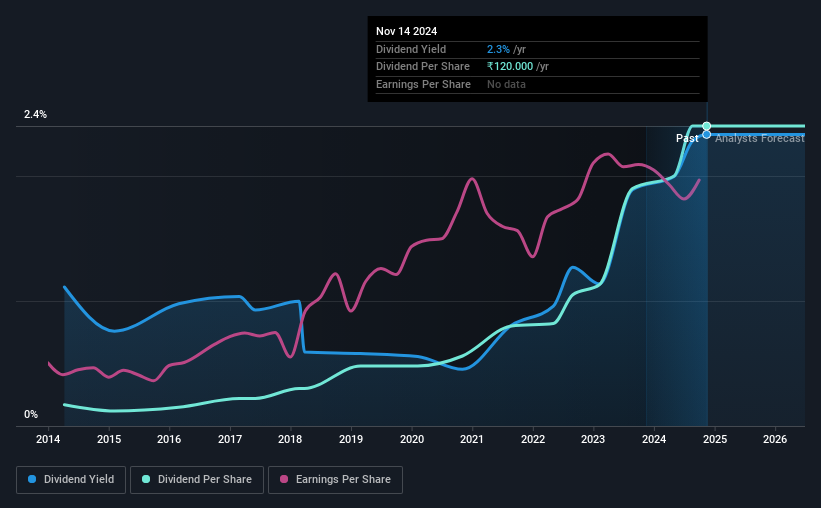Procter & Gamble Health (NSE:PGHL) Is Due To Pay A Dividend Of ₹60.00

Procter & Gamble Health Limited (NSE:PGHL) has announced that it will pay a dividend of ₹60.00 per share on the 4th of January. This will take the dividend yield to an attractive 2.3%, providing a nice boost to shareholder returns.
Check out our latest analysis for Procter & Gamble Health
Estimates Indicate Procter & Gamble Health's Could Struggle to Maintain Dividend Payments In The Future
Impressive dividend yields are good, but this doesn't matter much if the payments can't be sustained. Before making this announcement, Procter & Gamble Health was paying out quite a large proportion of both earnings and cash flow, with the dividend being 96% of cash flows. Paying out such a high proportion of cash flows certainly exposes the company to cutting the dividend if cash flows were to reduce.
Earnings per share is forecast to rise by 11.3% over the next year. If the dividend continues on its recent course, the company could be paying out several times what it earns in the next 12 months, which could start applying pressure to the balance sheet.

Dividend Volatility
The company has a long dividend track record, but it doesn't look great with cuts in the past. Since 2014, the dividend has gone from ₹8.50 total annually to ₹120.00. This works out to be a compound annual growth rate (CAGR) of approximately 30% a year over that time. Dividends have grown rapidly over this time, but with cuts in the past we are not certain that this stock will be a reliable source of income in the future.
Procter & Gamble Health Might Find It Hard To Grow Its Dividend
With a relatively unstable dividend, it's even more important to evaluate if earnings per share is growing, which could point to a growing dividend in the future. It's encouraging to see that Procter & Gamble Health has been growing its earnings per share at 10% a year over the past five years. EPS has been growing at a reasonable rate, although with most of the profits being paid out to shareholders, growth prospects could be more limited in the future.
Procter & Gamble Health's Dividend Doesn't Look Sustainable
Overall, we always like to see the dividend being raised, but we don't think Procter & Gamble Health will make a great income stock. In general, the distributions are a little bit higher than we would like, but we can't ignore the fact the quickly growing earnings gives this stock great potential in the future. We don't think Procter & Gamble Health is a great stock to add to your portfolio if income is your focus.
It's important to note that companies having a consistent dividend policy will generate greater investor confidence than those having an erratic one. Still, investors need to consider a host of other factors, apart from dividend payments, when analysing a company. For instance, we've picked out 1 warning sign for Procter & Gamble Health that investors should take into consideration. If you are a dividend investor, you might also want to look at our curated list of high yield dividend stocks.
New: Manage All Your Stock Portfolios in One Place
We've created the ultimate portfolio companion for stock investors, and it's free.
• Connect an unlimited number of Portfolios and see your total in one currency
• Be alerted to new Warning Signs or Risks via email or mobile
• Track the Fair Value of your stocks
Have feedback on this article? Concerned about the content? Get in touch with us directly. Alternatively, email editorial-team (at) simplywallst.com.
This article by Simply Wall St is general in nature. We provide commentary based on historical data and analyst forecasts only using an unbiased methodology and our articles are not intended to be financial advice. It does not constitute a recommendation to buy or sell any stock, and does not take account of your objectives, or your financial situation. We aim to bring you long-term focused analysis driven by fundamental data. Note that our analysis may not factor in the latest price-sensitive company announcements or qualitative material. Simply Wall St has no position in any stocks mentioned.
About NSEI:PGHL
Procter & Gamble Health
Engages in the manufacture and marketing of pharmaceuticals and chemical products in India and internationally.
Excellent balance sheet with proven track record.
Similar Companies
Market Insights
Community Narratives




